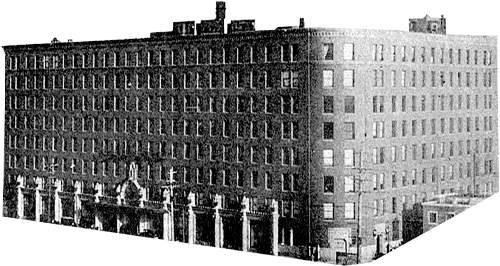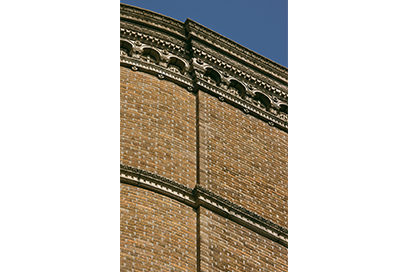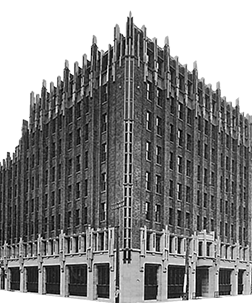 01
1925
01
1925
Osaka
The Daibiru-Honkan Building
Pioneering Efforts Toward a Full-Fledged Office Building Rental Business
Earthquake-Resistant Design as Proven by the Great Kanto Earthquake
The Great Kanto Earthquake of September 1, 1923, left behind some memorable scenes. While a number of buildings were left standing in Tokyo amidst the devastation, only one building remained unscathed. It was the Industrial Bank of Japan Head Office in Marunouchi, Chiyoda-ku, and it had been the first building in Japan to adopt earthquake-resistant construction. Its structural design had been led by Professor Tachu Naito, an expert on earthquake-resistant architecture from Waseda University. It had an earthquake-resistant and fire-resistant design based on Naito’s own calculation method, and this method was also used for the O.S.K. Lines Kobe Branch Building, which Watanabe designed. When this method demonstrated its resistance to earthquakes during the Great Kanto Earthquake, Watanabe decided to use it for the Daibiru-Honkan Building as well. Watanabe said, “(The Daibiru-Honkan Building) was the first building in Osaka to use earthquake-resistant construction.” Needless to say, this was a precursor to Daibiru’s later emphasis on earthquake resistance.
The Daibiru-Honkan Building was a strong reflection of Watanabe’s ambitions in a variety of other aspects besides earthquake-resistant design. One was the deliberate use of materials produced in Japan. Although the main concern was profitability, Watanabe was a strong advocate of the domestic production of building materials for which he previously had to rely on foreign imports, so he encouraged Japanese manufacturers to produce those materials locally. A prime example is Japanese terra cotta, which Watanabe utilized after a trial production run was undertaken by Osaka Ceramics (now Nihon Network Support, Co., Ltd.). This was, in fact, the start of terra cotta production in Japan. In addition to domestically produced scratched tiles and linoleum (from TOLI Corporation) and plaster (from Sikama Chemical Industry Co., Ltd., now Asada Chemical Industry Co., Ltd.), he had Toyo Toki Company, Limited (now TOTO Ltd.) copy some urinals that he had brought in from New York. As a result of these efforts, roughly 90% of the materials used for the Daibiru-Honkan Building were produced in Japan.
Watanabe also had the intention of adopting the “actual costs plus additional remuneration” method of calculating construction costs based on the rationalist principles used in the U.S. In principle, the client would purchase the necessary materials and pay contractors only the cost of overhead labor. The contractor guarantees a certain construction schedule and pays specific compensation in the case of construction schedule delays. If actual costs exceed or fall short of the construction estimate determined at the start of the contract, the construction costs are adjusted by adding or subtracting a percentage of that amount to or from the original construction costs. This helped to keep construction costs in check and made the building more profitable after opening.
-
1927 1931 Hibiya Daibiru Buildings
No. 1 and No. 2 -
2007 International Operations
-
- An Unexpected Discovery of a Good Property
- Mutual Trust and a Long-Term Perspective as Points of Agreement
- The Acquisition of a Property in Hanoi Through Unity of Philosophy
- Implementing Daibiru Quality Through Building Renovations
- Challenges in Australia, Our Second Overseas Expansion Target
- The Discovery of 275 George Street
- Difficult Contract Negotiations with JHG
- Overcoming Several Unexpected Difficulties
-



